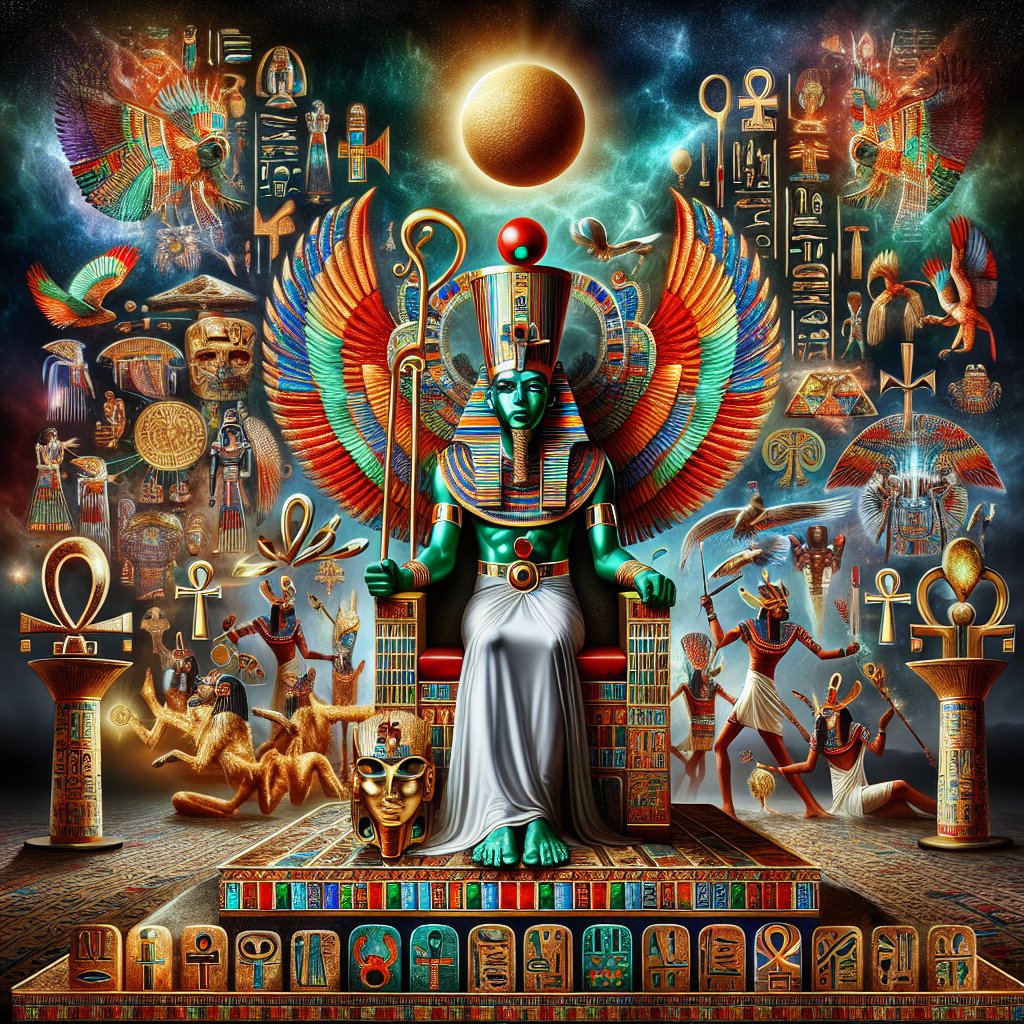Osiris: The God of the Afterlife and His Enduring Legacy
In the pantheon of ancient Egyptian deities, few figures are as significant or enduring as Osiris, the god of the afterlife, resurrection, and agriculture. Revered since the earliest dynasties, Osiris symbolizes the promise of rebirth and the eternal nature of life beyond death. His mythology reflects the ancient Egyptians’ beliefs about the afterlife, morality, and the cyclical nature of existence, themes that continue to resonate in various cultures today.
Origins and Mythology
Osiris emerged as a powerful deity around 2600 BCE, during the early phases of Egyptian civilization. He is often depicted as a mummified king, adorned with white robes and a crown of greenery, which symbolizes fertility and rebirth. His skin is frequently shown as green or black, colors associated with fertility and regeneration, respectively. As a central figure in Egyptian mythology, Osiris’ narrative is rich with themes of death, resurrection, and the moral order of the universe.
The most famous myth surrounding Osiris involves his murder by his brother Seth, the god of chaos and disorder. Osiris ruled as a just king of Egypt, teaching agriculture, law, and morality. Threatened by his popularity and righteous rule, Seth deceived and killed Osiris, dismembering his body and scattering the pieces across Egypt.
The story takes a transformative turn when Isis, Osiris’ devoted wife and sister, embarks on a quest to retrieve his scattered remains. Using her magical skills, she finds and reassembles Osiris, breathing life back into him. This act of resurrection not only reestablishes Osiris but also solidifies his position as the god of the afterlife. In a subsequent myth, Osiris descends into the underworld, becoming the ruler of the Duat, the realm of the dead, where he judges souls in the Hall of Maat, alongside his wife Isis and their son Horus.
Osiris in Egyptian Religion
Osiris’ significance transcended individual mythology; he represented the core principles of Egyptian religion. His stories reinforced core values such as justice, compassion, and the afterlife’s importance. The ancient Egyptians believed that the soul’s journey did not end with death but continued in the afterlife, where one’s actions in life determined their fate. The existential struggle against chaos, embodied by Seth, represented a constant battle for balance and order in the universe.
The judgment of the dead was a central tenet of Osiris’ worship. When people died, their hearts were weighed against the feather of Maat, the goddess of truth and justice. If a heart was lighter, the deceased was permitted to enter the paradise of the Field of Reeds, a place of eternal happiness. If heavier, they faced annihilation, consumed by the formidable entity Ammit. This belief system underscored the moral implications of one’s actions and decisions, fostering a culture that aspired toward justice and ethical living.
Cult and Worship
The worship of Osiris was widespread, with numerous temples dedicated to him throughout ancient Egypt. The most famous center of worship was the city of Abydos, considered the holiest site associated with Osiris. Pilgrims traveled from far and wide, seeking blessings and engaging in festivals in his honor.
One of the most significant events was the Osiris Mysteries, a series of rituals reenacting Osiris’ death and resurrection. These ceremonies involved dramatic performances depicting his murder, dismemberment, and subsequent resurrection, aiming to provide devotees with a tangible connection to the divine promise of rebirth. Such rituals reflected the Egyptians’ deep-seated belief in life after death, reinforcing community bonds and shared cultural values.
Osiris also played a pivotal role in the funerary practices of ancient Egypt. Royal tombs, filled with elaborate goods and offerings, served as a testament to the belief that the deceased would need these items in the afterlife. The iconic funerary text, the “Book of the Dead,” included spells and guidance to assist souls in navigating their journey to the afterlife, often invoking Osiris for protection and favor.
The Legacy of Osiris
The enduring legacy of Osiris reaches far beyond the confines of ancient Egypt. His influence permeated various aspects of Western civilization, shaping religious and philosophical thought. As a symbol of resurrection, Osiris parallels figures in other cultures, most notably in Christian traditions with the resurrection of Jesus Christ, showcasing universal themes of rebirth and hope.
Osiris’ mythology inspired countless artistic representations in paintings, sculptures, and literature, echoing throughout the ages. In contemporary culture, Osiris has found his place in literature and popular media, often depicted as a figure representing the quest for immortality and the mysteries surrounding life and death.
Moreover, the ideas surrounding judgment and the afterlife continue to impact modern spiritual beliefs. The notion that our actions have consequences in a broader existential context resonates with many people today, echoing Osiris’s moral and ethical teachings.
Conclusion
Osiris, the god of the afterlife and resurrection, remains one of the most influential figures in ancient Egyptian mythology. His stories reflect humanity’s enduring quest for understanding life, death, and the potential for renewal. As the central figure in a belief system that emphasized morality, justice, and the importance of the afterlife, Osiris has left a profound mark on cultural, religious, and philosophical thought throughout history.
In an ever-evolving world, the lessons embodied by Osiris continue to inspire exploration into our own understandings of existence, morality, and the sacred mysteries of life and death. Through rituals, storytelling, and the art of remembrance, Osiris thrives as a symbol of hope and rebirth, reminding us that even in the face of chaos, there exists the possibility of renewal and eternal life.






